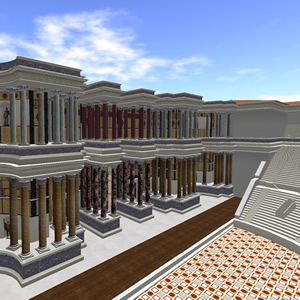The virtual theatres
Theatre of Pompey, Rome, Italy

- Theatre of Pompey in Second Life
The stage of the Theatre of Pompey was enormous: almost 100 metres wide. Immediately in front of the stage was the orchestra. In Roman theatres this space was rarely used for performance (unlike Greek practice when the orchestra was frequently used by the chorus for dancing). Instead important Roman officials including members of the Roman Senate, magistrates, and Priests had seats of honour here.
The first 14 rows of the cavea (which rose in concentric rows upon the level space of the orchestra) were reserved for Roman 'knights' who were members of the Equestrian order. Above them, the remaining rows up to the very top of the cavea were assigned by law to specific groups and classes of spectators. Foreigners, slaves and women were allowed to watch from the uppermost gallery at the back. The auditorium and its arrangement thus served as a microcosm of Roman society.